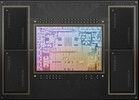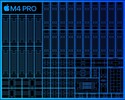Apple M2 Pro 16-Core GPU vs Apple M4 Max 40-Core GPU vs Apple M4 Pro 20-Core GPU
Apple M2 Pro 16-Core GPU
► remove from comparison
The Apple M2 Pro 16-Core-GPU is an integrated graphics card by Apple offering all 16 of the 19 cores in the M2 Pro 10-Core Chip.
The graphics card has no dedicated graphics memory but can use the fast LPDDR5-6400 unified memory with a 256 bit bus (up to 200 GBit/s).
According to Apple, the performance of the 19-core-GPU should be 30% higher than the old 16-core-GPU in the M1 Pro. Therefore, the cut down 16-core version should still beat the old full-featured 16-core M1 Pro slightly and the old 14-core more clearly.
The GPU is intended to use Apple Metal 2 API and could still be based on the older PowerVR architectures (last used in the Apple A10). A new feature in the MacBook Pro 14 of 2023 is the support for HDMI 2.1 and 8k output.
The Apple M2 Pro is manufactured in the second generation 5nm process at TSMC.
Apple M4 Max 40-Core GPU
► remove from comparison
The Apple M4 Max GPU (40 cores) is an integrated graphics adapter that's built into the 16-core Apple M4 Max SoC. It features 40 "cores" and has access to at least 48 GB of fast 546 GB/s LPDDR5x on-package RAM depending on the configuration. As is typical for graphics adapters released in 2024, it has hardware support for ray tracing as well as mesh shading and other modern technologies. It also supports external displays with resolutions as high as "8K" and can HW-decode a few popular video codecs such as h.264, h.265 and AV1.
Performance
Its gaming performance is set to be approximately as good as that of the GeForce RTX 4070 Laptop. Please keep in mind that very few games have been compiled specifically for Apple silicon Macs meaning most titles have to be run via emulation layers. Some of them are displayed with visual artefacts as a result, or don't start at all.
Power consumption
Given the power on offer, we expect the iGPU to consume over 45 W when under heavy loads.
Just like the rest of the Apple M4 Max chip, the integrated graphics adapter is manufactured on a "second generation 3 nm" TSMC process which is still cutting-edge as of late 2024.
Apple M4 Pro 20-Core GPU
► remove from comparison
The Apple M4 Pro GPU (20 cores) is an integrated graphics adapter designed by Apple that's built into the 14-core Apple M4 Pro SoC. It features 20 "cores" and has access to at least 24 GB of fast 273 GB/s LPDDR5x on-package RAM depending on the configuration. As is typical for graphics adapters released in 2024, it has hardware support for ray tracing as well as mesh shading and other modern technologies. It also supports external displays with resolutions as high as "8K" and it can HW-decode a few popular video codecs such as h.264, h.265 and AV1.
Performance
Its gaming performance is at least as good as that of the GTX 1660 Ti Laptop. Please keep in mind that very few games have been compiled specifically for Apple silicon Macs meaning most titles have to be run via emulation layers. Some of them are displayed with visual artefacts as a result, or don't start at all.
- The Witcher 3 1080p Ultra = 53 fps (close to the GTX 1660 Ti Laptop)
- Baldur's Gate 3 1440p Ultra = 42 fps (close to the GeForce RTX 4050 Laptop)
- Cyberpunk 2077 2.1 Phantom Liberty 1080p Ultra = 40 fps (close to the GTX 1660 Ti Laptop)
In synthetic benchmarks, the iGPU is about 30% faster than the old M3 Pro GPU and is even on par with a fast GeForce RTX 4070 Laptop GPU (3DMark Wild Life Extreme Unlimited).
Power consumption
When under heavy CPU and GPU load, the iGPU portion of the 14-core M4 Pro consumes about 32 W according to monitoring software "powermetrics". With no load, it makes do with as little as 1 W to 3 W.
Just like the rest of the Apple M4 Pro chip, the integrated graphics adapter is manufactured on a "second generation 3 nm" TSMC process which is still cutting-edge as of late 2024.
| Apple M2 Pro 16-Core GPU | Apple M4 Max 40-Core GPU | Apple M4 Pro 20-Core GPU | |||||||||||||||||||||||||||||||||||||||||||||||||||||||
| Apple M4 Series |
|
|
| ||||||||||||||||||||||||||||||||||||||||||||||||||||||
| Pipelines | 16 - unified | 40 - unified | 20 - unified | ||||||||||||||||||||||||||||||||||||||||||||||||||||||
| Memory Type | LPDDR5-6400 | LPDDR5x-8533 | LPDDR5x-8533 | ||||||||||||||||||||||||||||||||||||||||||||||||||||||
| Shared Memory | no | yes | yes | ||||||||||||||||||||||||||||||||||||||||||||||||||||||
| technology | 5 nm | 3 nm | 3 nm | ||||||||||||||||||||||||||||||||||||||||||||||||||||||
| Notebook Size | medium sized | large | |||||||||||||||||||||||||||||||||||||||||||||||||||||||
| Date of Announcement | 17.01.2023 | 30.10.2024 | 30.10.2024 | ||||||||||||||||||||||||||||||||||||||||||||||||||||||
| Raytracing Cores | 40 | 20 | |||||||||||||||||||||||||||||||||||||||||||||||||||||||
| Memory Speed | 8533 MHz | 8533 MHz | |||||||||||||||||||||||||||||||||||||||||||||||||||||||
| Memory Bandwidth | 546 GB/s | 273 GB/s | |||||||||||||||||||||||||||||||||||||||||||||||||||||||
| Power Consumption | 45 Watt | 45 Watt | |||||||||||||||||||||||||||||||||||||||||||||||||||||||
| Predecessor | M3 Max 40-Core GPU | M3 Pro 18-Core GPU | |||||||||||||||||||||||||||||||||||||||||||||||||||||||
| Displays | 3 Displays (max.) |
|
|
| ||||||||||||||||||||||||
Benchmarks
Cinebench R15 OpenGL 64 Bit + Apple M2 Pro 16-Core GPU
GFXBench T-Rex HD Offscreen C24Z16 + Apple M2 Pro 16-Core GPU
Average Benchmarks Apple M2 Pro 16-Core GPU → 100% n=8
Average Benchmarks Apple M4 Max 40-Core GPU → 265% n=8
Average Benchmarks Apple M4 Pro 20-Core GPU → 147% n=8
* Smaller numbers mean a higher performance
1 This benchmark is not used for the average calculation
Game Benchmarks
The following benchmarks stem from our benchmarks of review laptops. The performance depends on the used graphics memory, clock rate, processor, system settings, drivers, and operating systems. So the results don't have to be representative for all laptops with this GPU. For detailed information on the benchmark results, click on the fps number.

Total War Pharaoh
2023
Baldur's Gate 3
2023
Borderlands 3
2019
The Witcher 3
2015
GTA V
2015Average Gaming Apple M2 Pro 16-Core GPU → 100%
Average Gaming 30-70 fps → 100%
Average Gaming Apple M4 Max 40-Core GPU → 247%
Average Gaming Apple M4 Pro 20-Core GPU → 142%
Average Gaming 30-70 fps → 148%
| Apple M2 Pro 16-Core GPU | Apple M4 Max 40-Core GPU | Apple M4 Pro 20-Core GPU | |||||||||||||||||||
|---|---|---|---|---|---|---|---|---|---|---|---|---|---|---|---|---|---|---|---|---|---|
| low | med. | high | ultra | QHD | 4K | low | med. | high | ultra | QHD | 4K | low | med. | high | ultra | QHD | 4K | ||||
| Total War Pharaoh | 74.1 | 61.8 | 56.1 | 56 | 56 | 50 | 65 | 55 | 51 | 51 | 49 | ||||||||||
| Cyberpunk 2077 2.2 Phantom Liberty | 49.1 | 48.7 | 48.5 | 47.4 | 43 | 21.3 | 50 | 48 | 45 | 40 | 25 | ||||||||||
| Baldur's Gate 3 | 164 | 131 | 101 | 99 | 69 | 35 | 91 | 78 | 64 | 62 | 43 | ||||||||||
| Shadow of the Tomb Raider | 159 | 72 | 65 | 57 | 36 | 167 | 143 | 129 | 94 | 51 | 181 | 110 | 100 | 87 | 57 | ||||||
| The Witcher 3 | 51 | 45 | 157 | 107 | 78 | 61 | 85 | 53 | |||||||||||||
| Apple M2 Pro 16-Core GPU | Apple M4 Max 40-Core GPU | Apple M4 Pro 20-Core GPU | |||||||||||||||||||
| low | med. | high | ultra | QHD | 4K | low | med. | high | ultra | QHD | 4K | low | med. | high | ultra | QHD | 4K | < 30 fps < 60 fps < 120 fps ≥ 120 fps | 1 | 1 | 1 1 | 2 | 1 | | < 30 fps < 60 fps < 120 fps ≥ 120 fps | 1 1 1 | 1 1 2 | 2 1 2 | 2 2 1 | 2 3 | 1 3 1 | < 30 fps < 60 fps < 120 fps ≥ 120 fps | 1 2 1 | 2 2 | 2 3 | 3 2 | 1 3 | |
For more games that might be playable and a list of all games and graphics cards visit our Gaming List














